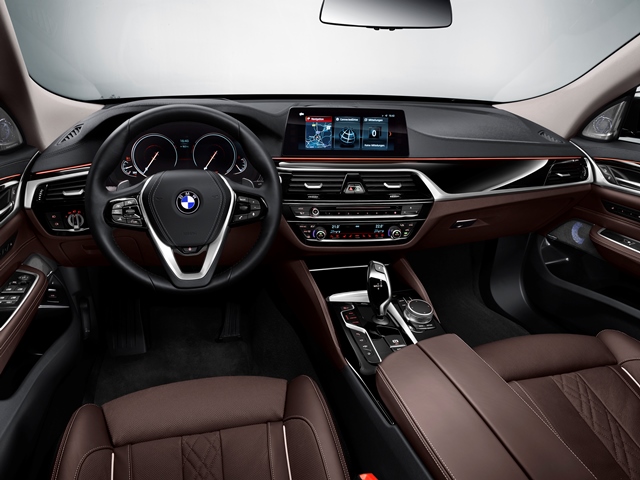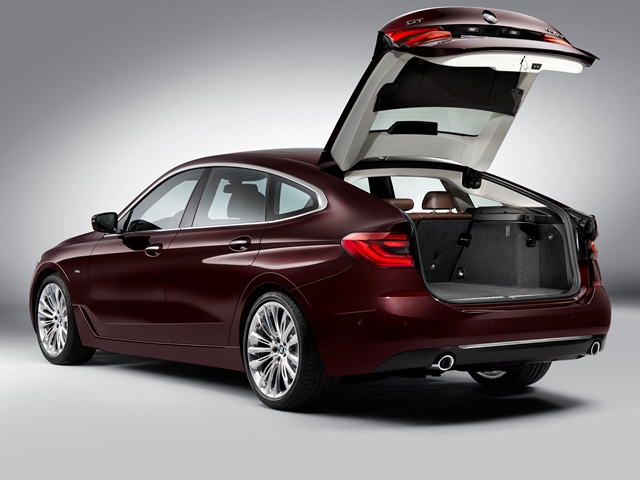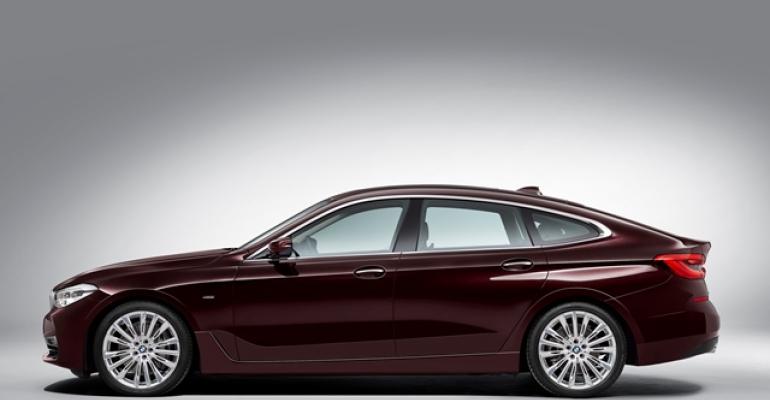BMW reveals the new 6-Series Gran Turismo, a five-door successor to the 5-Series GT set to make its public debut at the Frankfurt auto show in September and scheduled for North American deliveries in early 2018.
Considered a rival to the new Audi A7, the five-seat GT has been thoroughly redesigned with a more shapely exterior and a roomier interior featuring higher-quality materials consistent with those seen on the latest 5-Series, together with the latest developments in BMW’s semi-autonomous driver-assistance systems, gesture control and connectivity functions.
The 6-Series GT forms part of an expanded four-strong lineup of 6-Series models. While BMW remains tight-lipped on its future plans, WardsAuto learns the existing 6-Series Coupe, Cabriolet and Gran Coupe are set to cease production within the next two years in a move that will leave the new liftback as the sole model bridging the gap between the smaller 5-Series and larger 7-Series by the end of the decade.
The adoption of the 6-Series name for the new BMW model is in line with the German automaker’s effort to place greater emphasis on luxury at the upper end of its lineup. Today’s 6-Series Coupe and Cabriolet will be indirectly replaced by the 8-Series Coupe revealed at the recent Villa d’Este Concourse d’Elegance, and by its Cabriolet sibling in 2018 and 2019, respectively.
The 6-Series GT draws heavily on the latest 5- and 7-Series models. Together with the new name, it adopts BMW’s latest CLAR (cluster architecture platform), which endows it with preliminary weight savings of up to 331 lbs. (150 kg) compared with the 5-Series GT through greater use of aluminum and hot-formed high-strength steel within its body structure.
The new platform supports a more advanced 12V flex-ray electrical system that ushers in a number of chassis developments. The standard suspension features rear air springs and automatic self-leveling. But as with the 5- and 7-Series, buyers can specify a more advanced optional air suspension featuring air springs both front and rear, together with variable damping control and active roll control.
The new BMW model also offers optional all-wheel drive and integral active rear steering on upper-end models, a combination lacking on the old 5-Series GT, which was introduced in 2009 and facelifted in 2012 with the adoption of a simpler one-piece tailgate in place of the original model’s complex two-piece arrangement.
Stylistically, the 6-Series GT combines BMW’s latest design lineage with the five-door liftback bodystyle of the 5-Series GT. The new look incorporates a bolder front end and more shapely rear to achieve a drag co-efficient of 0.25 in its most basic, narrow wheeled, 630i GT form. To increase downforce at higher speeds, it features an automatically extending spoiler integrated into the trailing edge of the tailgate.

As with its predecessor, the new model receives frameless doors and a power liftback that hinges from atop the rear window to reveal a trunk featuring a 3.9 cu.-ft. (102-L) increase in cargo capacity over the 5-Series GT at a nominal 21.5 cu.-ft. (609 L). With the standard 40/20/40 split rear seats folded, cargo volume rises to 63.6 cu.-ft. (1,800 L).
At 200.4 ins. (5,090 mm) long, 74.9 ins. (1,902 mm) wide and 60.6 ins. (1,539 mm) high, the 6-Series GT is 3.4 ins. (86 mm) longer from stem to stern than the 5-Series GT but retains the same width and sneaks in 0.8 ins. (20 mm) lower. It rides on a wheelbase that is the same as its predecessor at 120.9 ins. (3,070 mm).
For context, the latest 5-Series sedan, alongside which the new GT will be produced in Dingolfing, Germany, measures 194.2 ins. (4,935 mm) long, 73.5 ins. (1,868 mm) wide and 57.7 ins. (1,466 mm) high. The 5-Series also uses a wheelbase that is 3.7 ins. (95 mm) shorter than that of the 6-Series GT at 117.1 ins. (2,975 mm).
Details to North American models are yet to be made public, although BMW confirms European customers will be able to choose between four equipment lines: Standard, Sport, Luxury and M-Sport, as well as five different wheel sizes of 17-, 18-, 19-, 20- and 21-ins.
Inside, the 6-Series GT shares its appointments with the 5-Series, albeit with a slightly higher seating position up front and rear seats that can be ordered with optional electrical adjustment. Highlights include an optional 10.3-in. (26-cm) touchscreen infotainment display and the latest generation of the BMW head-up display unit, as well as conversational voice control and gesture control.
BMW confirms a limited lineup of gasoline and diesel engines for the 6-Series GT, which will be offered exclusively with an 8-speed automatic gearbox equipped with a torque converter and, in combination with its initial 6-cyl. engines, the option of either standard rear-wheel drive or optional all-wheel drive.

Among the gasoline units in the initial three-model launch for Europe is a base turbocharged 2.0L 4-cyl. developing 258 hp and 295 lb.-ft. (400 Nm) of torque in the rear-wheel-drive 630i GT. It is claimed to hit 62 mph (100 km/h) from standstill in 6.3 seconds and a limited 155 mph (250 km/h) top speed in combination with combined-cycle fuel consumption of 45.6 mpg (5.2 L/100 km).
Further up the lineup is the 640i GT. It receives the latest evolution of BMW’s 3.0L inline turbo 6-cyl. tuned to deliver 340 hp and 332 lb.-ft. (450 Nm) of torque. The initial, range-topping AWD 6-Series xDrive GT model delivers a 0-62 mph time of 5.3 seconds and is limited to a top speed of 155 mph with combined fuel consumption of 36.7 mpg (6.4 L/100 km).
The sole diesel at launch is a 3.0L turbo inline 6-cyl. that develops 265 hp and 457 lb.-ft. (620 Nm) of torque in the 630d GT. In standard RWD guise, it sprints to 62 mph in 6.1 seconds and also is limited to a top speed of 155 mph. Combined cycle fuel consumption is estimated at 57.7 mpg (4.1 L/100 km).
Additional models are planned to follow in 2018, including an entry-level 620d GT fitted with a 2.0L turbo 4-cyl. diesel rated at 188 hp.
BMW officials also hint at an M550i xDrive GT running a 4.4L twin-turbo gasoline V-8 with 456 hp and an M550d xDrive GT powered by BMW’s newly unveiled 3.0L inline quad-turbo 6-cyl. diesel delivering 395 hp.
Also under development at BMW’s engineering headquarters in Munich is a plug-in gasoline-electric hybrid model insiders suggest will take the name 640e GT. It combines a gasoline 2.0L turbocharged 4-cyl. with an electric motor mounted within the forward section of its gearbox to deliver a combined system output of 322 hp.
Among the 6-Series GT’s technical highlights is a broad range of semi-autonomous driving functions, including BMW’s latest stop-and-go active cruise control, steering and lane-control assistant, lane-departure warning with integrated side-collision warning, cross-traffic warning, wrong-way warning and a remote-control parking assistant operated via an optional display key.
As part of an updated suite of connectivity options, the new BMW also is claimed to offer improved smartphone integration with optional wireless inductive charging and a Wi-Fi hotspot for up to 10 devices.





